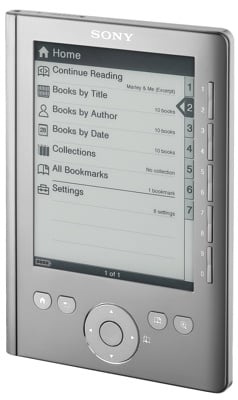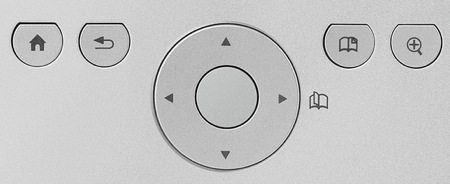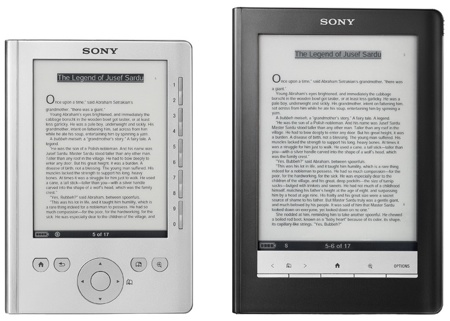Original URL: https://www.theregister.com/2009/11/17/review_e_book_reader_sony_prs_300_pocket/
Sony Reader PRS-300 Pocket Edition
The e-book reader for everyone?
Posted in Personal Tech, 17th November 2009 13:02 GMT
Review With the price of the Reader PRS-600 Touch Edition having been hiked up by 25 per cent over the original PRS-505, Sony clearly thinks there's room for a cheaper alternative. Hence the launch of the Reader PRS-300 Pocket Edition which does without a touchscreen and has a 5in rather than 6in screen.

Sony's Reader Pocket Edition:
In the UK, the Pocket sells for £180. While that's a hefty £70 cheaper than the Touch, it's worth remembering that it's only 20 quid less than the old 505 sold for.
Physically, the Pocket resembles a shrunken and tidied up version of the 505. At 107 x 158 x 10mm, it's the same thickness as the Touch, but 14mm narrower and 17mm shorter. At 220g, it weighs a noticeable 66g less.
Without a touchscreen, the controls are once again placed on the device's face, but there are only ten rather than the 17 the 505 had, and the layout is far neater.
The ten number keys from the 505 have been condensed into five rocker buttons, while the navigation keys have been simplified into a circular navpad and four buttons to, respectively, take you to the Home menu, zoom in or out on text – though you only get three size options rather than the five you get with the Touch – add a bookmark, and go back a step.

The controls and their layout are better this time round
All in all, it's well thought out and a big improvement on the 505, though the menus don't react quite as quickly to commands as they do on the Touch.
Nothing has been sacrificed in the build quality, with the Pocket having the same robust and attractive aluminium case as the Touch complete with ersatz book spine on the left and profile taper on the right.

There's no memory expansion slot on this model
Comparing the technically identical in all but screen-size Touch and Pocket side by side, it has to be said that the contrast of the 5in unit is superior. The 12 months that passed between us using the original Reader and the new Touch obscured the difference in contrast between the touch-sensitive and non-touch sensitive versions of E Ink's e-paper screen, but it was more obvious when we placed the Touch and Pocket next to each other.
Not that we are changing our opinion about the legibility of the Touch's screen - it does the job and is eminently fit for purpose - it's just that, on balance, we prefer the lighter grey background of the Pocket's screen.
Out of the box and in the hand, the 5in display looks smaller than you might expect it to from a glance at the numerical dimensions or at product images. The upside is that the Pocket also feels smaller in the hand than those same dimensions and pictures suggest, making it a very comfortable one-handed read. The device is also very easy to slip into a coat or jacket pocket.
The reduced screen size doesn't have any impact on the readability of ePub or BBeB text, which can be viewed at the same size as it can on the 6in screen - there's just less of it on each page. PDF files are more problematic as the formatting suffers when you zoom in from a whole page view with letters being orphaned at the end of sentences and paragraph returns arranging themselves rather randomly.

Again, standard mini USB is used for charging and data transfer
Size issues apart, the the most obvious differences between the Pocket and the Touch are the absence of anything in the way of storage expansion and the lack of a music player, both present on the more pricey model. These both seem rather strange omissions to us.
Yes, you can still squeeze a fair-sized library into the Pocket's 512MB of built-in storage. Well, 380-odd MB after the system software takes a bite, but that is still enough for 225 copies of War and Peace or 600 of Moby Dick in ePub format. But not fitting a memory card slot of one form or another for those who want to carry a larger number of larger files about does seem both parsimonious and daft.

Pocket (left) and Touch: does an inch make a difference?
Presumably, Sony has shorn the Pocket of storage expansion to avoid taking sales from the Touch but that makes the Pocket look like poor value when compared to the 505, which had memory expansion slots and a larger screen but only cost £20 more, including an extra 2.5 per cent of VAT.
The absence of a music player is also a let down. One of our reservations about the Touch was the continuation of the 505's very basic AAC/MP3 player, but to remove the functionality altogether? That gets right up our noses here at Register Hardware as we regularly used both the Touch and 505 Readers to listen to music while reading.
Of course, without memory expansion you'd be stuck for anywhere to put your music files but that just underlines what a bad idea it was not fitting any storage expansion in the first place.
Format support is unsurprisingly identical to the Touch, so the Pocket will handle EPub and BBeB – with and without DRM – as well as PDF, Word, plain text and RTF files. Battery life has taken a small hit with Sony quoting 6800 page turns to the Touch's 7500, though in day-to-day use the difference is unlikely to be noticed.
Verdict
Sony has missed an opportunity to pitch the Pocket Edition as the iPod Nano to the Touch Edition's iPod Touch. Sure the Pocket is a fine bit of kit as far as it goes – it's well made, light, compact and provides a fine reading experience – but at £180 its far, far too expensive for something which as had so much functionality stripped away. If the UK Reader line-up was priced closer to the US range – at $199 and $299 (£120 and £180) - we would be far more enthusiastic. ®
More E-book Reader Reviews...

Sony PRS-600 Touch |

Bookeen Cybook Opus |

Interead Cool-er |

iRex DR1000S |